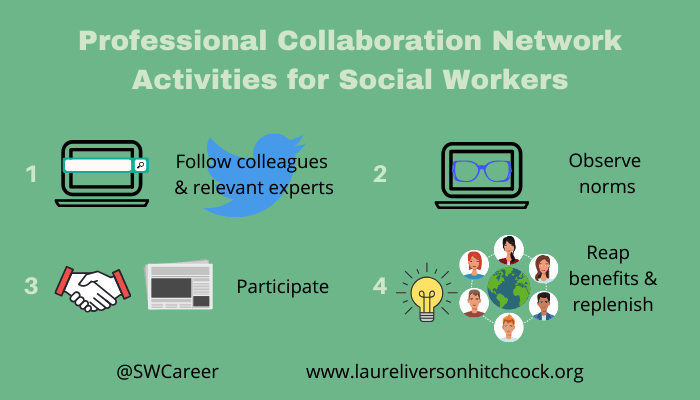Professional Collaboration Networks for Social Work Practice

In this post, I am outlining previously published content from this blog about the concept and practice of a Professional Collaboration Network (PCN), which are technology-mediated user-centered relationship constellations designed to enhance or enrich connections, knowledge, and professional opportunities. Using PCNs in social work practice started as an idea at a Think Tank hosted by the University at Buffalo’s School of Social Work in June 2019. The Think Tank’s goal was to brainstorm how to teach students in their new online Doctorate of Social Program (DSW) program to develop critical stakeholder networks using digital and social technologies. You will find a summary of each of the five original blog posts, along with a link to the full post.
Academic and Professional Blogging
Editor’s Note: This post is one in a series about how technology can be used to develop and sustain one’s professional network. The idea for this post came from a think tank hosted by the University at Buffalo’s School of Social Work in June 2019, looking for a way to teach students in their new online Doctorate of Social Program (DSW) program about how to develop key stakeholder networks in relation to a substantive topic area. In this series, we are exploring the concept of a Professional Collaboration Network (PCN), which are technology-mediated user-centered relationship constellations designed to enhance or enrich connections, knowledge, and professional opportunities. This post reviews how academic and professional blogging can be used to share and curate information for practice communities.

Blogs, and the act of blogging, have come a long way since the mid 1990’s when they essentially performed as personal journals published on the internet; they are now often fully fledged outlets for journalism, advocacy, and academic research (Smith, 2010, Kanter and Fine, 2010, Kirkup, 2010, Rosenberg, 2009). Although some may feel that blogging has become passé in the current and crowded social media landscape, others would argue blogging is alive and well (Fiesler, 2019; Perry, 2015). The main goal of this blog post is to describe why and how academic blogging can help contribute to your Professional Collaboration Network (PCN), and offer some basic tips for getting started. To learn more about PCNs, please read this post:
Today most people know what a blog is; in fact ,you are staring at one right now. The bigger question as academics or professionals is why would we want to develop/maintain a blog? Here we dive into just a few of the many answers to this question:
Using Twitter at a Professional Conference
Editor’s Note: This post is one in a series about how technology can be used to develop and sustain one’s professional network. The idea for this post came from a think tank hosted by the University at Buffalo’s School of Social Work in June 2019, looking for a way to teach students in their new online Doctorate of Social Program (DSW) program about how to develop key stakeholder networks in relation to a substantive topic area. In this series, we are exploring the concept of a Professional Collaboration Network (PCN), which are technology-mediated user-centered relationship constellations designed to enhance or enrich connections, knowledge, and professional opportunities. This post covers the use of Twitter at professional conferences as a way to share your insights and extend the reach of the conference sessions.
This is the fourth blog post in a series on using Twitter to create Professional Collaboration Networks (PNCs). Previous posts included:
- What is a Professional Collaboration Network (PCN) & why do you need one?
- Twitter for your Professional Collaboration Network (PCN)
- How do you do relational Twitter?: Developing your Professional Collaboration Network

In this blog post, we discuss how Twitter can be used at a professional social work conference. There are at least two important reasons why tweeting at conferences is a valuable practice. First, attending conferences requires resources and time. Not everyone has the ability to attend all conferences, and one person certainly cannot attend all of the conferences that interest them. By tweeting from a conference, participants can share what they learned in sessions with anyone who is interested. Not only does this extend the reach of the knowledge shared at a conference, it makes content accessible to individuals and groups who might not be able to attend. Curating all the tweets from a conference can create an informal transcript of the happenings at a conference from multiple points of view. Second, tweeting at a conference allows an individual another way to network and meet people. Creating a public list of individuals and groups on Twitter who are attending the conference can supplement a stack of business cards and allow you to engage with more people during and after the conference. Alternatively, if you can’t attend a conference, you can follow the tweets of users who are at the conference and reply with your questions. There are even some conferences that occur only on Twitter (check out @Biotweeps).Third, it can increase your visibility in a particular subject area. For example, if you are presenting at the conference, you have the opportunity to share a photo and information from your session. The suggestions in this post come from the real life experiences of the authors as well as recommendations gleaned from articles written about conference tweeting.
How do you do relational Twitter?: Developing your Professional Collaboration Network
Editor’s Note: This post is one in a series about how technology can be used to develop and sustain one’s professional network. The idea for this post came from a think tank hosted by the University at Buffalo’s School of Social Work in June 2019, looking for a way to teach students in their new online Doctorate of Social Program (DSW) program about how to develop key stakeholder networks in relation to a substantive topic area. In this series, we are exploring the concept of a Professional Collaboration Network (PCN), which are technology-mediated user-centered relationship constellations designed to enhance or enrich connections, knowledge, and professional opportunities. This post covers how you can develop and nurture professional relationships with Twitter.
This is the third blog post in a series on using Twitter to create Professional Collaboration Networks (PNCs). Previous posts defined PCNs and discussed the value of Twitter as a network and how it can benefit lifelong learning, and shared some best practices. There are many professional reasons for being on Twitter, including disseminating one’s own work, announcing happenings, seeking help, and learning from others. To be successful in most of these tasks, you need to be plugged into a social network of people who are motivated to share your work. This post addresses how one moves from using Twitter to follow others and announce your work to developing real relationships with the real people at the keyboards.

This post is built from real-life experience of the amazing professional experiences and friendships that can come from the effective use of PCNs. About six years ago, I (Melanie, the first author of this post) connected with a small group of social workers who were using Twitter, which led me to connect with folks like Jonathan Singer (@socworkpodcast) who I went on to present and write book chapters with, and Laurel Hitchcock and Nancy Smyth, with whom I spent three years writing the book Teaching Social Work with Digital Technology. Beyond these meaningful work products, social work relationships on Twitter have evolved into sharing meals, spending time in each other’s homes, and splitting Airbnb’s at social work conferences across the nation. Not to mention people I can lean on, and am happy to support on good and hard days.
Twitter for your Professional Collaboration Network (PCN)
Editor’s Note: This post is one in a series about how technology can be used to develop and sustain one’s professional network. The idea for this post came from a think tank hosted by the University at Buffalo’s School of Social Work in June 2019, looking for a way to teach students in their new online Doctorate of Social Program (DSW) program about how to develop key stakeholder networks in relation to a substantive topic area. In this series, we are exploring the concept of a Professional Collaboration Network (PCN), which are technology-mediated user-centered relationship constellations designed to enhance or enrich connections, knowledge, and professional opportunities. This post covers how you can use Twitter to create and support your PCN.
In light of our living in a time of rapid technological change and our professional mandate to keep up-to-date with the advances in our field, (Council on Social Work Education, 2015; National Association of Social Workers, 2018), social workers may benefit from building a professional collaboration network (PCN). We previously defined what a Professional Collaboration Network is this blog post: What is a professional collaboration network and why do you need one?

In essence, a PCN is created by social workers who connect with other professionals online for the purpose of learning and exchanging information. Prior to the ubiquitous use of the internet, professionals would typically keep up with the latest developments in their field via networking with their peers at conferences and continuing education opportunities, as well as via printed newsletters, magazines and trade publications. Nowadays, there are many technological tools to facilitate interactions with individuals across different disciplines, states or the world. PCNs typically include various online communities such as Twitter, LinkedIn, Facebook, social bookmarking sites and more.
What is a Professional Collaboration Network (PCN) & why do you need one?
Editor’s Note: This is the first in a series of blog posts about how technology can be used to develop and sustain one’s professional network. The idea for this post came from a think tank hosted by the University at Buffalo’s School of Social Work in June 2019, that I attended along with the other authors of this post. Our goal at this think tank was to brainstorm how to teach students in their new online Doctorate of Social Program (DSW) program about how to develop key stakeholder networks using digital and social technologies. In this series, we are exploring the concept of a Professional Collaboration Network (PCN), which are technology-mediated user-centered relationship constellations designed to enhance or enrich connections, knowledge, and professional opportunities. This post covers the “whys” and “whats” of a PCN.

Social media and other forms of digital technologies are ubiquitous tools for communication in the 21st century, including in the lives of clients and communities served by social workers. It is clear technological tools are being used to create and maintain relationships when a third of America’s marriages now start online (Cacioppo, Cacioppo, Gonzaga, Ogburn, & VanderWeele, 2013), and 69% of internet users utilize social media, 74% of those daily (Pew Research, 2018). Social work professionals need to understand how these tools work, and learn to use them for creating and maintaining professional relationships with colleagues, communities, and the vulnerable populations served by the profession, and disseminating information to communities of interest.


